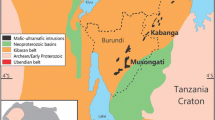Abstract
Abundant cinnabar (HgS) mineralization is associated with the Pinchi Fault in central British Columbia. Two formerly producing mercury mines have been developed on this fault: Pinchi and Bralorne Takla. The mercury content of till (a sediment type directly deposited by glaciers) in the area of this fault is primarily controlled by the occurrence of cinnabar mineralization in bedrock and the direction of ice flow. Cinnabar-bearing bedrock was eroded by glaciers, transported in the direction of ice flow, and deposited "down-ice" from its source. An example of such a dispersal train is documented for the Pinchi Mine area where mercury ore was transported over a distance of 12 km, as measured in the clay-sized fraction (< 0.002 mm) of till, and could have been transported over 24 km according to heavy mineral concentrates (specific gravity >3.3) of this same sediment. Antimony, chromium, and nickel dispersal trains were also detected in the region. These data indicate that natural glacial processes can result in the "mobilization" of metals in the surficial environment, a factor which has to be considered at mine sites in glaciated terrain, where mine reclamation and remediation measures are now required.
Similar content being viewed by others
Author information
Authors and Affiliations
Additional information
Received: 31 October 1996 · Accepted: 27 May 1997
Rights and permissions
About this article
Cite this article
Plouffe, A. Detrital transport of metals by glaciers, an example from the Pinchi Mine, central British Columbia. Environmental Geology 33, 183–196 (1998). https://doi.org/10.1007/s002540050237
Issue Date:
DOI: https://doi.org/10.1007/s002540050237




